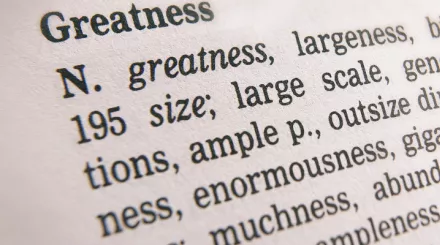This year’s theme of Speak Up North 2024 is belonging. If you’re thinking about submitting a short story for your Speak Up North entry, you may find this guidance as a good starting point to find inspiration, structure, and learn how to edit your work. There are no strict rules for the structure or length of a short story – but we’d recommend that your short story is no longer than 1000 words. Your work should also be related to the theme of belonging in some way.
Note that to exhibit your work, you should either type your short story or, if written by hand, use single pages of A4 and avoid writing on both sides of your paper. This is because the ink may bleed through the paper and make it more difficult to read.
What is a short story?
Traditionally, short stories were meant to be read in a single sitting —usually between 20 minutes to an hour. A short story is one of the most common forms of writing. It is often used to describe a single event, a single episode, or a tale of one particular character. The narrative style may either be first person or third, or whichever the author chooses. The setting of a short story is often simplified (one time and place), and one or two main characters may be introduced without full backstories.
Most short story authors create a distinct mood using classic literary devices (point of view, imagery, foreshadowing, metaphor, word choice, tone, and sentence structure).
Poetry is when an emotion has found its thought, and the thought has found words.Robert Frost

What is belonging?
Where to start
Sometimes, knowing where to start can be the most difficult step in writing. You can find inspiration from all around you and art that already exists to create something new and something that’s you. Here are five different ways you may take inspiration:
1. Take the first line from an existing poem and use it to start a new piece of writing.
- “On this street, the houses lean in, whispering” – Canal Street Blues, Carol Ann Duffy
- “My grandfather left Liverpool in ‘62” – Ghost Train to Liverpool, Lemn Sissay
- “Beneath the roar of Anfield’s crowd, a heartbeat shared, belonging loud” – Kop Chorus, Tony Harrison
2. Use an existing song title as the title and/or first line of your story and let it inspire you.
3. Stand somewhere where you feel like you belong. Close your eyes and listen. Write down any sounds or voices you hear. Write down the emotions you feel.

Merseyside

Greater Manchester

West Yorkshire
4. Use a picture or photo to inspire you. Look through your phone or at old photographs or use Google to search for images of places.
5. Start with an object. Describe it in vivid detail. Now explain who it belongs to.
Structure of a poem
Some poems have rules. With some poems though, the only rule is that there are no rules. The great thing about poetry is that it can be whatever you want it to be. Some poets use rhyme and meter to create a musical effect, while others use free verse to create a more conversational flow to their writing. Some poets use imagery to create vivid pictures in the reader’s mind, while others use simpler language to get directly to the point.
If you prefer to follow a structure or want to explore different types of poetry, then Penguin’s guide on different types of poetry is a good starting point.

Vocabulary and phrases
1. Use a thesaurus to find synonyms for what you’re writing about
- Synonyms for ‘belong’: match, permeate, associate, fit, become, harmonise, apply, exist, reside
- Synonyms for ‘belonging’: acceptance, association, inclusion, loyalty, affinity, kinship, acceptance
- Phrases that mean ‘to belong’: be connected with, be part of, be linked to
2. Use set phrases to start each line of poetry
Some examples of line starters, relating to belonging, could be:
- I remember...
- I want to tell you / I don't want to tell you...
- They say...
- Here's to...
- I come from...
- I am writing from a place that...
- There was a time when...
- Belonging is...
- Home is...
To help you generate more ideas, a great exercise could be to start every line of your poem with the same line starter. This may help you to generate ideas at first, or even construct a whole poem out of this technique. Check out, for example, Wislawa Szymborksa's poem 'Possibilities,' read by Amanda Palmer.

3. Seek inspiration from writing and poetry that you like
What makes a good poem
"A good poem creates a world that somehow touches the reader. That world is built of images that come to the reader through vivid sense details and the music of vivacious language." - Paul Janeczko. A Poke in the I. Candlewick, 2001. Seeing the Blue Between: Advice and Inspiration for Young Poets. Candlewick, 2002.
We at Tutor Trust are looking for three main things in your finished piece of writing:
- The ability to tell a compelling story, convey an idea, and/or create a feeling or mood
- Creativity
- Use of language (including imagery)
“Details make stories human, and the more human a story can be, the better.” — Ernest Hemingway
Editing your poem
The best writers review their work with a fresh pair of eyes after finishing a first draft. There are a few things you can do in the editing stage to make your poem even better than it already is.
Read for content and ideas
The main aim of a poem is to convey a clear idea. Read over your poem, from a reader’s viewpoint, to ensure that what you are saying makes sense.
Edit line-by-line
Having a sharper focus on individual lines will help you spot what you’re doing well and where you may change a few things.
Check for spelling, grammar, and punctuation (SPaG)
You may want to use a dictionary or a digital spell checker to check for spelling, grammar, and punctuation. You may also want to ask your class teacher or your parent, carer, or guardian to check it as well.
Review your vocabulary
You may want to use a thesaurus to make your verbs stronger and consider synonyms.
If you come across any cliché phrases (these are phrases that are overused), think about replacing them with something more unique. You may do this by looking for an alternative phrase or adding a more specific description, which will make your work more original.
Often, removing quantifiers such as ‘really’ and ‘very’ makes your writing more concise and to the point.
Read your poem out loud
This will ensure that the story you’re telling is clear, the language you use is effective, and if you’re using a set rhyming and meter, that it sounds like you imagined it too.
More poetry resources
You can also find out more about Speak Up North, including guest judges, prizes, and more!

